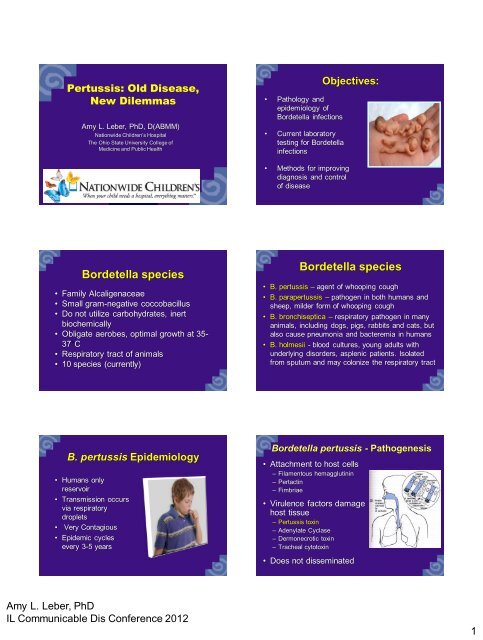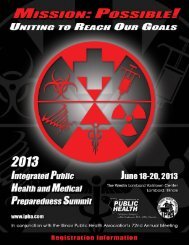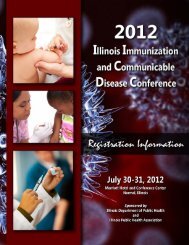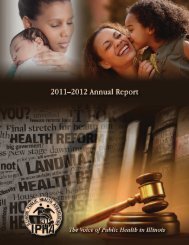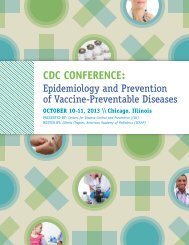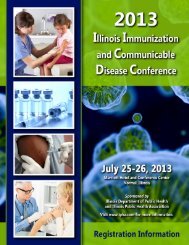Pertussis Presentation
Pertussis Presentation
Pertussis Presentation
Create successful ePaper yourself
Turn your PDF publications into a flip-book with our unique Google optimized e-Paper software.
<strong>Pertussis</strong>: Old Disease,<br />
New Dilemmas<br />
Amy L. Leber, PhD, D(ABMM)<br />
Nationwide Children’s Hospital<br />
The Ohio State University College of<br />
Medicine and Public Health<br />
• Pathology and<br />
epidemiology of<br />
Bordetella infections<br />
• Current laboratory<br />
testing for Bordetella<br />
infections<br />
Objectives:<br />
• Methods for improving<br />
diagnosis and control<br />
of disease<br />
Bordetella species<br />
• Family Alcaligenaceae<br />
• Small gram-negative coccobacillus<br />
• Do not utilize carbohydrates, inert<br />
biochemically<br />
• Obligate aerobes, optimal growth at 35-<br />
37 C<br />
• Respiratory tract of animals<br />
• 10 species (currently)<br />
Bordetella species<br />
• B. pertussis – agent of whooping cough<br />
• B. parapertussis – pathogen in both humans and<br />
sheep, milder form of whooping cough<br />
• B. bronchiseptica – respiratory pathogen in many<br />
animals, including dogs, pigs, rabbits and cats, but<br />
also cause pneumonia and bacteremia in humans<br />
• B. holmesii - blood cultures, young adults with<br />
underlying disorders, asplenic patients. Isolated<br />
from sputum and may colonize the respiratory tract<br />
B. pertussis Epidemiology<br />
• Humans only<br />
reservoir<br />
• Transmission occurs<br />
via respiratory<br />
droplets<br />
• Very Contagious<br />
• Epidemic cycles<br />
every 3-5 years<br />
Bordetella pertussis - Pathogenesis<br />
• Attachment to host cells<br />
– Filamentous hemagglutinin<br />
– Pertactin<br />
– Fimbriae<br />
• Virulence factors damage<br />
host tissue<br />
– <strong>Pertussis</strong> toxin<br />
– Adenylate Cyclase<br />
– Dermonecrotic toxin<br />
– Tracheal cytotoxin<br />
• Does not disseminated<br />
Amy L. Leber, PhD<br />
IL Communicable Dis Conference 2012<br />
1
Epidemiology<br />
• Catarrhal -runny nose, sneezing, low fever, and a mild cough; similar to<br />
a common cold and gradually become more severe.<br />
• Paroxysmal - bursts or paroxysms of numerous, rapid coughs. These<br />
coughing episodes seem to be due to a difficulty in expelling mucus from<br />
the tracheobronchial tree; end with a long inspiratory effort accompanied<br />
by the high pitched whoop from which the disease gets its name.<br />
• Convalescent – gradual recovery but cough may persist for months<br />
Clinical Case<br />
• 8 - week old female was seen in the ER<br />
with 2 week history of paroxysmal<br />
cough, progressing to her gasping for<br />
breath and vomiting.<br />
• Clear chest X-ray, pulse 160, respiration<br />
70, fever of 38.0 o C. WBC 16,000/mm 3<br />
with 70% lymphocytes.<br />
Classic <strong>Presentation</strong><br />
Clinical Case<br />
15 yo female presents to<br />
her pediatrician with<br />
history of coughing fits<br />
for 4 weeks duration<br />
interfering with sleep.<br />
No fever, whoop or<br />
posttussive vomiting.<br />
Common <strong>Presentation</strong><br />
<strong>Pertussis</strong><br />
Control of <strong>Pertussis</strong><br />
“A disease of<br />
adolescents and adults<br />
that can kill infants.”<br />
– 90% of deaths from<br />
pertussis in infants<br />
• Antimicrobial<br />
Treatment<br />
• Infection Control<br />
Measures<br />
• Vaccination<br />
Aust Fam Physician. 2007 Jan-Feb;36(1-2):51-6<br />
Amy L. Leber, PhD<br />
IL Communicable Dis Conference 2012<br />
2
<strong>Pertussis</strong> Vaccine<br />
Childhood Vaccination:<br />
• 1940s – whole cell<br />
vaccine introduced (DTP)<br />
• 1991 – acellular DTaP<br />
vaccine approved for 4 th<br />
and 5 th dose<br />
• 1996 – DTaP approved<br />
for complete series of 5<br />
shots.<br />
http://www.cdc.gov/vaccines/schedules/downloads/child/0-18yrs-pocket-pr.pdf<br />
Waning Immunity<br />
Protection following:<br />
Immunization in Adolescents<br />
• Natural Infection 10-15 years<br />
• Vaccination*<br />
5-10 years?<br />
*(full childhood series)<br />
Case Definitions<br />
Clinical Diagnosis Complications<br />
• Heterogeneity of disease expression<br />
• Level of immunity at the time of<br />
exposure<br />
• Modification of disease by immunization<br />
• Mixed infections and infections with other<br />
Bordetella sp.<br />
• Low index of suspicion by physician<br />
Amy L. Leber, PhD<br />
IL Communicable Dis Conference 2012<br />
3
Laboratory Diagnosis<br />
• Culture – Gold Standard<br />
• DFA<br />
• Serology<br />
• NAAT<br />
Specimen Collection<br />
• Nasopharyngeal<br />
specimen<br />
– Want ciliated epithelial cells<br />
– Timing critical<br />
• NP aspirates, washes, or<br />
swabs are acceptable<br />
– Throat swabs are not<br />
acceptable<br />
http://www.copanusa.com/downloads/education/<br />
Culture<br />
• Sensitivity 30 – 60%<br />
• Specificity 100%<br />
• Factors effecting sensitivity<br />
– Type and quality of specimen<br />
– Time specimen obtained in<br />
the course of illness<br />
– Appropriate transport<br />
– Choice of culture media<br />
– Length of time cultures<br />
incubate<br />
Direct Fluorescent Antibody<br />
• Sensitivity (18-78%)<br />
• Specificity (56-93%)<br />
• Advantage<br />
– More rapid than culture<br />
• Technically challenging<br />
• Because of its limitations, CDC does not<br />
recommend use of DFA testing.<br />
Serology<br />
• No FDA-approved diagnostic tests<br />
• Paired sera are desirable for best results<br />
• Antigens used: PT, FHA, Pertactin<br />
• No standard criteria<br />
• Antibodies elicited by infection and<br />
vaccination, complicating interpretation.<br />
• CDC – not relied on for case confirmation<br />
Timing of Serologic Testing<br />
Amy L. Leber, PhD<br />
IL Communicable Dis Conference 2012<br />
4
IS Ct<br />
PCR<br />
• Majority of Labs using LDA real-time PCR<br />
• Each laboratory must validate assay<br />
– PCR +, Culture –<br />
– Imperfect Gold Standard<br />
• Conditions and Reagents vary<br />
• Sample Type and Collection<br />
Method vary<br />
PCR in Adolescents/Adults<br />
Clinical Infectious Diseases 2007; 44: 1216-1219<br />
Targets for PCR<br />
• Toxin Gene Promoter (PtxnP)<br />
– single copy gene<br />
– specific for B. pertussis<br />
• Insertion Sequence 481 (IS481)<br />
– Multicopy gene<br />
– B. pertussis 50-200 copies/cell<br />
– B. holmseii 10 copies/cell<br />
– B. bronchiseptica<br />
• Insertion Sequence 1001 (IS1001)<br />
– B. parapertussis<br />
– 35-50 copies/cell<br />
PCR at Nationwide CH<br />
• Testing since 1993, evolution of methods<br />
• Currently offering Real Time PCR<br />
– Target: IS 481 for B. pertussis<br />
IS 1001 for B. parapertussis<br />
– Extraction: MagNA Pure Compact<br />
– Amplification: ABI 7500<br />
– Specimen: 2 NP swabs transported in casamino<br />
acids<br />
– Cut-off for positive results Ct ≤ 37<br />
Real Time PCR<br />
• Add slide on how to interpret Real time<br />
PCR<br />
Crossing<br />
threshold (Ct)<br />
40<br />
35<br />
30<br />
25<br />
20<br />
15<br />
PCR Detection of B. pertussis:<br />
Toxin Promoter vs IS 481 Target<br />
(Single vs Multi copy)<br />
Tox Ct -vs- IS Ct<br />
y = 0.9367x - 5.2046<br />
R 2 = 0.8317<br />
10<br />
10 15 20 25 30 35 40 45<br />
TOX Ct<br />
Amy L. Leber, PhD<br />
IL Communicable Dis Conference 2012<br />
5
Setting a Cut-Off value for IS481 PCR<br />
• High Ct values may represent low<br />
bacterial load<br />
– Ct values >35 correlate with 90% outpatients<br />
We noticed an increase in positivity from Client A.<br />
• Looked at data from that office only.<br />
# Tested<br />
# Pos<br />
(Ct≤37)<br />
% Pos<br />
(Ct≤37)<br />
# neg w/Ct<br />
(>37)<br />
% neg w/Ct<br />
(>37)<br />
126 65 51.6% 55 43.7%<br />
Pediatric Infectious Disease Journal Vol. 13,<br />
1994<br />
• Environmental<br />
monitoring<br />
performed<br />
• B pertussis DNA<br />
detected with PCR<br />
• Whole cell vaccine<br />
Amy L. Leber, PhD<br />
IL Communicable Dis Conference 2012<br />
6
Pediatric Infectious Disease Journal Vol. 27,<br />
2008<br />
Initial Environmental and Personnel Testing at Site A<br />
Site A Environmental Samples<br />
Dr K, Self-Collected<br />
Dr G, Self-Collected<br />
Bp IS481 PCR<br />
Ct<br />
Neg<br />
Neg<br />
Nurse, 1 38.1<br />
Nurse, 2 39.1<br />
Nurse, 3 39.3<br />
Nursing Station:<br />
Area Near Fridge And Fridge Handle<br />
(Vaccine And Bp Collection Kit Storage)<br />
31.7<br />
Nursing Station - Computers/Phones 34.8<br />
POC Testing Area 34.8<br />
Exam Room 2 37.0<br />
Exam Room 3 36.4<br />
Exam Room 6 34.5<br />
Exam Room 8 36.3<br />
Break Room 36.3<br />
Lobby, Sick Kids Side<br />
Uninoculated Collection Kit From Fridge<br />
Neg<br />
Neg<br />
Pediatric Office: Common Practices<br />
Contamination of Environment with Target<br />
Vaccine Prep Area<br />
Ct values 21-25<br />
Collection Kits<br />
Pentacel<br />
• Vial 1 – liquid DTaP–IPV<br />
• Vial 2 – Lyophilized Hib<br />
1 2<br />
Detection of Bordetella pertussis DNA in Acellular Vaccines and in Environmental Samples from<br />
Pediatric Physician Offices A Leber, et al.. 2010. Interscience Conference in Antimicrobial Agents<br />
and Chemotherapeutics (ICAAC), Boston, MA.<br />
Amy L. Leber, PhD<br />
IL Communicable Dis Conference 2012<br />
7
Patient Results vs. Vaccines Used<br />
on Site<br />
Environmental Contamination<br />
Detection of Bordetella pertussis DNA in Acellular Vaccines and in Environmental Samples from<br />
Pediatric Physician Offices A Leber, et al.. 2010. Interscience Conference in Antimicrobial Agents<br />
and Chemotherapeutics (ICAAC), Boston, MA.<br />
Detection of Bordetella pertussis DNA in Acellular Vaccines and in Environmental Samples from<br />
Pediatric Physician Offices A Leber, et al.. 2010. Interscience Conference in Antimicrobial Agents<br />
and Chemotherapeutics (ICAAC), Boston, MA.<br />
How to Mitigate Environmental Contamination<br />
• Test only symptomatic<br />
patients<br />
• Separate sample collection<br />
from vaccine administration<br />
• Wear gloves<br />
• Consider different sample<br />
type or transport (dry<br />
transport for NP swabs)*<br />
• Clean*<br />
Practice A –Effect of Cleaning on IS481 DNA in<br />
Environment 10% Bleach following by Isopropyl Alcohol<br />
Location of Wipe Testing<br />
Pre-clean<br />
Postclean<br />
Fridge with vaccine and counter 33.7 39.2<br />
Exam Room 6, exam table 37.6 neg<br />
Exam Room 6, door handle/light<br />
switch<br />
33.8 38.9<br />
Exam Room 6 sind area /scales 36.6 neg<br />
Break Room 36.2 neg<br />
http://www.cdc.gov/pertussis/clinical/diagnostic-testing/diagnosis-pcr-bestpractices.html<br />
Leber et al., Unpublished data.<br />
Increasing Incidence<br />
Increasing Incidence in Adolescents<br />
• Decreased vaccination due to concerns<br />
• Waning adolescent and adult immunity<br />
• Lower protection from acellular vaccines<br />
• Increased awareness by physicians<br />
• More sensitive laboratory testing<br />
• Strain Variability<br />
• Other Bordetella Species<br />
Amy L. Leber, PhD<br />
IL Communicable Dis Conference 2012<br />
8
Increasing Incidence in Adolescents<br />
Booster Vaccine<br />
• 2005 –Tdap<br />
approved for<br />
Adolescent Booster<br />
• 2006 – Adult Booster<br />
FIGURE 3. Incidence of confirmed and probable pertussis among<br />
persons aged ≤19 years, by patient age and vaccines received* —<br />
National Notifiable Diseases Surveillance System, United States,<br />
January 1–June 14, 2012<br />
Other Bordetella Species?<br />
Bordetella parapertussis<br />
• 1-5% of pertussis patients<br />
• Same virulence factors except<br />
<strong>Pertussis</strong> toxin<br />
• Little cross-immunity between B.<br />
pertussis and parapertussis<br />
MMWR: July 20, 2012 / 61(28);517-522<br />
Immunization is not protective for B.<br />
parapertussis.<br />
Not a reportable disease<br />
Other Bordetella species?<br />
Outbreak in Central Ohio 2010-2011<br />
Anatomy of an Outbreak<br />
Role of B. holmesii<br />
• B pertussis outbreak was confirmed<br />
– IS481 positive<br />
– BptxPr positive<br />
• B. holmesii was co-circulating<br />
– IS481 positive<br />
– IS1001-like positive<br />
• Isolated in culture<br />
• Serology (CDC) on limited subset showed:<br />
– Antibody to PT in B. pertussis infected<br />
– No antibody in B holmesii infected<br />
Unpublished data<br />
Amy L. Leber, PhD<br />
IL Communicable Dis Conference 2012<br />
9
Impact of Target Copy Number on Ability of<br />
PCR to Confirm IS481 Positives<br />
Interpretation of PCR Results:<br />
PCR Target<br />
(Copy #)<br />
IS481<br />
(Bpert 200; Bholm 10)<br />
Toxin Promoter<br />
(Bpert 1; Bholm 0)<br />
IS-1001 like<br />
(Bpert 0; Bholm 5)<br />
Unpublished data<br />
Organism and Mean Cts of<br />
IS481 Positives<br />
B pertussis<br />
B holmesii<br />
26.3 28.8<br />
34.5 Neg<br />
Neg 29.7<br />
IS481<br />
Target<br />
PtxPr<br />
IS1001<br />
like<br />
Interpretation<br />
+ + − B. pertussis<br />
+ − + B holmesii<br />
+ − − ???<br />
Targeting IS481 vs <strong>Pertussis</strong> Toxin Promoter<br />
IS481 +/ Toxin promoter − / IS1001like −<br />
• True positive for B. pertussis but:<br />
– Unable to confirm due to relative insensitivity of PCR for<br />
single copy toxin promoter vs repetitive IS481 target<br />
• False positive for B. pertussis due to:<br />
– Contamination of PCR reactions with low level B<br />
pertussis DNA from environmental sources<br />
• vaccine DNA in office practice<br />
• amplicon DNA in lab<br />
• genomic DNA in either setting<br />
Laboratory Diagnosis of <strong>Pertussis</strong><br />
Unanswered Questions:<br />
• Change the cutoff for IS481 PCR<br />
– Eliminate some of the “false” positives?<br />
• Routinely do Bptxp and Bholmseii PCR on all<br />
IS481 positives.<br />
– Report out B holmesii?<br />
• Change to a specific, single copy target<br />
• Incorporate serology into testing algorithms<br />
• Resurrect culture<br />
The <strong>Pertussis</strong> Dilemma:<br />
• “…remains endemic<br />
in the United States<br />
despite routine<br />
childhood vaccination<br />
for more than half a<br />
century and high<br />
coverage levels in<br />
children for more than<br />
a decade.”<br />
http://www.cdc.gov/mmwr/preview/mmwrhtml/rr5503a1.htm<br />
Conclusions<br />
• <strong>Pertussis</strong> continues to be an endemic disease<br />
affecting infants and adolescents/adults.<br />
– Immunization of those with waning immunity is<br />
important<br />
• Laboratory diagnosis has improved<br />
– PCR being the new (but flawed) “gold standard”.<br />
– A well standardized, widely available serology is<br />
needed<br />
• Increasing incidence of disease is multifactorial.<br />
– Efficacy of vaccine for long term immunity<br />
– Role of B. holmesii and other species<br />
– Environmental contamination<br />
Amy L. Leber, PhD<br />
IL Communicable Dis Conference 2012<br />
10
Thank-you<br />
Questions?<br />
amy.leber@nationwidechildrens.org<br />
Amy L. Leber, PhD<br />
IL Communicable Dis Conference 2012<br />
11


